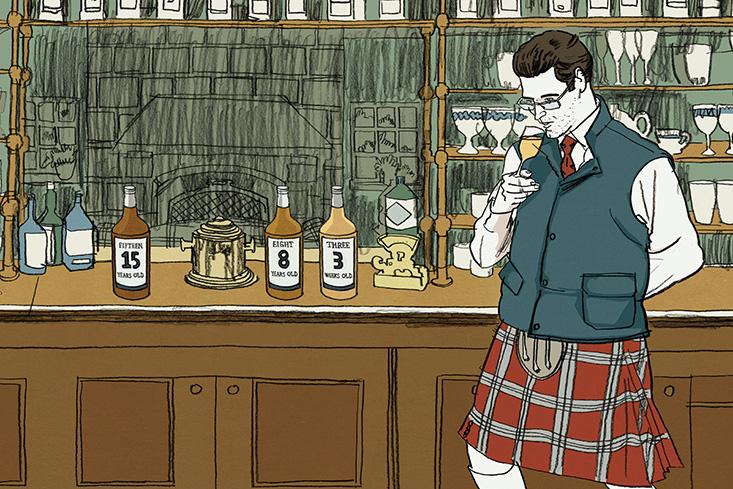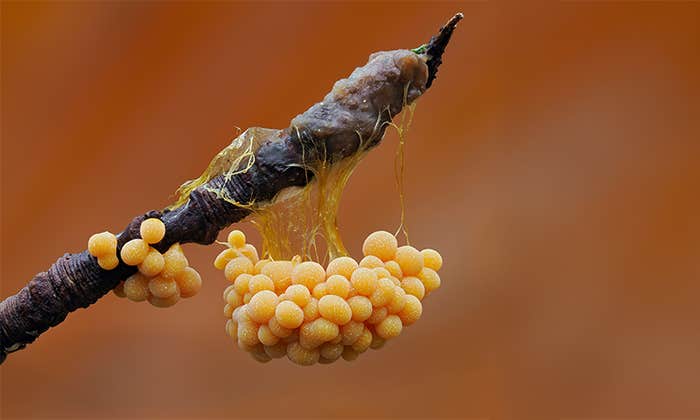In case you haven’t heard, doomsday is coming—more droughts, floods, famine, class warfare, entitled children, and, brace yourself: a bourbon shortage! Yes, traditional Kentucky distillers didn’t predict or prepare for this Mad Men-inspired mixology epoch. And if it continues on this trajectory, thousands of years from now geologists and archaeologists will be able to identify the bourbon-free era in the absence of fancy rectangular bottles in the remains of fallen civilizations.
That is, unless scientists can build a whiskey time machine, a way to gracefully cheat the slow aging process that offers bourbon its rich oaky tones and sweet and smooth finish.
The popularity of bourbon in the past decade has been a major high and hangover for American distillers. (The name “bourbon” is reserved for barrel-aged whiskeys made primarily of corn in the United States.) In 2002, the U.S. sold 13 million cases of bourbon; in 2014, 19 million cases, generating $2.7 billion in revenue. But the popularity and the time bourbon takes to mature, paired with a shortage of new American oak barrels that traditional whiskeys are aged in, means there simply isn’t enough of the good stuff to go around. Evidence of a shortage is generally delivered in anecdotes, but in an independent opinion survey taken this year by Fred Minnick, booze blogger and author of Whiskey Women: The Untold Story of How Women Saved Bourbon, Scotch & Irish Whiskey, 82 percent of 149 high-end bourbon drinkers said they have been unable to find bourbons they once found.
Scientifically savvy distillers have already squeezed the slow aging process into months and weeks.
It is the finest bourbons, those that are produced in limited supply and aged for 12, 18, or more years that have been the hardest to find in the past several years. Drinkers with deep pockets have bought up much of the limited release bourbons from well-established companies—Van Winkle, Buffalo Trace Antique Collection, Four Roses Limited Editions—explains Lew Bryson, the managing editor of Whisky Advocate magazine. “Having cleared them off the market, they’ve now started in on lesser-known bourbons, almost in a panic-buying mode, buying multiple bottles of whiskeys they feel sure will simply disappear.”
It’s a frightening prospect.
Enter entrepreneurs with start-up spirits and a potential solution. Through a variety of unconventional aging methods, drawing on chemistry, they have already squeezed a two- to more-than-20-year process into days, weeks, and months, much to the chagrin of whiskey connoisseurs, who will tell you the secret to a refined bourbon is time. While some companies have taken age labels off their bottles to get products to market sooner (bye-bye 12-year-old premium bourbon; hello ambiguously aged premium bourbon), new distilleries are experimenting with smaller barrels and rapid oxidation.
The magic that turns harsh ethanol, the product of distillation, into a sophisticated sip of smooth bourbon with undertones of vanilla and caramel happens when young alcohol meets oak barrel. Whiskey aging traditionally starts when an oak barrel is charred, breaking down the lignin in the wood into organic compounds called aldehydes, explains Scott Spolverino, an industry consultant with a degree in brewing and distilling science from Heriot-Watt University, in Scotland. “These are the main building blocks of maturation.” When you add alcohol to the barrel, oxidation transforms the aldehydes into acids—syringic acid (from syringaldehyde), ferulic acid (from coniferaldehyde), and vanillic acid (from vanillin). During the aging process, changes in heat and pressure push and pull the alcohol in and out of the wood. There is a constant back-and-forth between aldehyde and acid, until the acids accumulate en masse and turn permanently into esters, adding complex character and deep flavors.
“Time in the barrel is like sandpaper, smoothing out the rough edges,” says Liza Weisstuch, who writes regularly for Whisky Magazine and the Whisky Advocate.

But a host of new distillers don’t want to wait years to start cashing in on their hefty investments. One entrepreneur trying to cheat Father Time is Tuthilltown Spirits in Gardiner, New York, makers of Hudson Baby Bourbon and Hudson Four Grain Bourbon. When it opened in 2003, Tuthilltown started experimenting with accelerating the maturation of single malt, rye, and bourbon whiskeys by letting the alcohol settle in 2- to 5-gallon oak barrels, instead of the industry-standard 53- to 55-gallon oak casks, increasing the alcohol-to-barrel-surface ratio.
“The small barrels sped up aging significantly; we could get to market in months, instead of years,” says Tuthilltown co-owner Ralph Erenzo, a rock climber who originally wanted Tuthilltown to be a climbers’ ranch. Erenzo and his crew were able to get their whiskey to market in about four months, and they discovered they liked the more pronounced vanilla flavor they were getting by using small barrels. Ten years out, and with the luxury of time, they have grown into bigger barrels—using, for the most part, a mix of 10-, 26-, and 53-gallon casks. But they still have a reserve of 3- to 5-gallon whiskey that they blend with bigger batches so they can “get that character profile that people liked all along,” Erenzo says. In 2010 Tuthilltown sold its Hudson line to William Grant & Sons Distillers, makers of Glenfiddich single malt Scotch whiskies and Hendrick’s Gin.
Spirits aged for short amounts have an edgy taste often described as “hot,” “raw” or “aggressive.”
At Copper Fox Distillery in Sperryville, Virginia, makers of Wasmund’s Single Malt Whisky and Copper Fox Rye Whisky, head distiller and owner Rick Wasmund adds toasted oak chips to his 53-gallon barrels, agitating them to increase the alcohol-to-surface ratio and exposing them to heat and cold. You can try your hand at similar bourbon aging methods at home with something called Time & Oak—an oak stick with comb-like grooves that activates “accelerated transpiration through capillary action”—the same theory behind smaller barrels and oak chips.
Terressentia, near Charleston, South Carolina, which specializes in bulk bourbon (sold in 6,000-gallon tankers), uses increased oxidation to mimic aging and take impurities out of young whiskeys, explains Terressentia CEO Earl Hewlette. Terressentia starts with undrinkable 4- to 6-month-old whiskey because they want their whiskey to be brown—something you can’t get without time in an oak barrel. They filter it in plastic tanks with a technology that expedites the aldehyde and acid dance, creating drinkable esters—chemical compounds—in just eight hours. According to Hewlette, the process has the added benefit of turning some of the fatty acids from the original fermented grains into glycerides, which act as a smoothing agent, taking the bite out of the final product. “When the bourbon shortage came along, it gave us a whole new market,” says Hewlette, noting that the same bigger companies who used to sell in bulk have been hoarding their own limited supplies.
Tom Lix, owner of the Cleveland Whiskey Company, uses steel tanks with wood segments under pressure. “One of the reasons behind working on the technology we use and starting this business was an anticipation of this shortage well in advance of when other people started talking about it,” he says. Lix also boasts that his Cleveland Black Reserve 100-proof spirit, the company’s bourbon, holds its own in taste tests against established brand Knob Creek.
Bourbon made in less than a year may be financially savvy, but most bourbon experts say it falls short on taste. “I don’t think new methods are producing whiskey that is comparable,” Bryson says. “Some accelerated whiskeys don’t feel right. They feel too thin; they don’t have the proper ‘roundness.’ ”
Spolverino explains: “When you’re aging a spirit for a short amount of time, the aldehydes and acids don’t have time to come together.” Meaning those raw flavors in fast-tracked whiskeys often come from an overabundance of aldehydes. “Adding more wood to the situation just adds more of those beginning aldehydes, it doesn’t actually speed up the process,” he says. Spirits aged for shorter amounts of time (four months instead of the two years minimum for federally approved straight bourbon, for example), have an edgy taste, often described as “hot,” “raw,” or “aggressive,” with a “shorter finish.” Spolverino has done research into an ultrasonic-energy treatment. “It could physically push the spirit deeper into the barrel staves to draw out more aldehydes and provide catalytic energy for reactions,” he says. “But I’m not entirely sure it could speed up the esterification process.”
Many of the big distillers stepped up production of high-end whiskey five years ago, when word of a shortage started to spread. And there has always been a plentiful supply of non-premium brands: Jim Beam White, Evan Williams Black, Knob Creek, Woodford Reserve, Maker’s Mark, 1792, explains Bryson. Most of the big companies dismiss accelerated aging. Mark Brown, CEO of Buffalo Trace, one of Kentucky’s larger bourbon distilling operations, says the company has spent $10 million on research and development on how to make quality whiskey, not on how to cheat time.
“The work done by others over the past 50 years aimed at expediting the aging process does not appear to have resulted in the production of a superior whiskey, quite the opposite,” says the company’s Master Distiller, Harlen Wheatley. “We’re glad people are exploring these [new] techniques,” says Brown. “But generally it only reinforces the need for time in the barrel.”
Tasha Eichenseher is a hot-toddy-sipping, freelance science and environment writer (and a senior editor at Yoga Journal) in Boulder, Colorado.


























